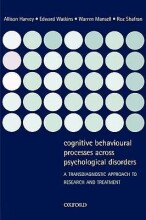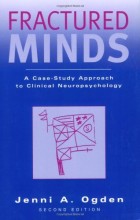Summary: Cognitive Behavioral Processes | 9780198528883 | Harvey, et al
- This + 400k other summaries
- A unique study and practice tool
- Never study anything twice again
- Get the grades you hope for
- 100% sure, 100% understanding
Read the summary and the most important questions on Cognitive behavioral processes | 9780198528883 | Harvey and Watkins
-
2 Attention
This is a preview. There are 26 more flashcards available for chapter 2
Show more cards here -
Emotional Stroop task
Participants selective attention to the content of the word interfered with their response to name the colour of the ink -
To what kind of stimuli do people selectively attend to
People select their attention to certain things; novel stimuli attract attention, or stimuli with certain physical properties (such as bright, moving or painful stimuli). These tend to be important from an evolutionary perspective, because they either reward or threaten. For example, negative faces are noticed faster than neutral ones. We also focus on personally relevant stimuli -
Eye tracker (Visual scanpath)
Focus on eye gaze over time, it cannot measure covert attention. We can also focus our attention on things we do not put our eye on (this is only for a short amount of time however) -
Body dysmorphic disorder
An inward focused attention with lots of staring at your appearance. They gazed in the mirror more than controls and people with BDD focused more on how they felt about themselves or how they felt they appeared rather than their actual reflection. They also showed extended colour-naming latencies for emotional words in the Emotional Stroop, but most of all with positive words related to appearance. -
3 Memory
This is a preview. There are 31 more flashcards available for chapter 3
Show more cards here -
Perceptually driven/data driven tasks
Perceptually-driven/data-driven tasks require the processing of the perceptual features of word stimuli (An encoding task would be to recall all the ‘e’s in a word, a retrieval task completes a word stem in precisely the same way as was presented earlier) -
Transfer appropriate processing
if the processing activities required by the retrieval task are similar to the encoding task, it will be easier to recall. This means that even if you fail to remember something, you might still have it as memory but via a different process. This theory has major implications for memory processes partaking on disorders. -
Verbally accessible memory
VAMs were given sufficient conscious attention during the trauma and thus were encoded in a way that permits the interaction of the memory with the rest of the autobiographical memory system, making later memory search and retrieval relatively easy. -
Situation accessible memory
Subconsiously generated memories. SAMs are information that received minimal processing and are thereby encoded using a lower-level and largely perceptual system that does not interact with the rest of the autobiographical knowledge base. -
Panic disorders w/without agoraphobia
Explicit memory bias for concern-relevant words. Implicit memory showed mixed findingsAgoraphobia - all patients but no control participants, reported having distinct recurrent images that were typically linked with past memories of disstressing events, such as being neglected or abused at home and being attacked. -
Avoidant encoding and retrieval
People suffering from psychological disorders, particularly those disorders that involve exposure to trauma, are thought to adopt an avoidant encoding and retrieval style in an attempt to themselves from and cope with the traumatic information.Recurrent memories - images experienced by people are important for unlocking the meaning of the symptoms
- Higher grades + faster learning
- Never study anything twice
- 100% sure, 100% understanding

































